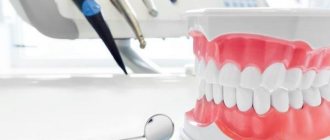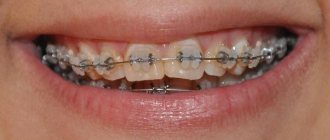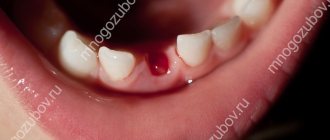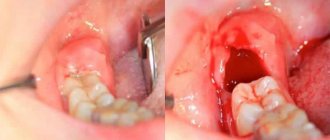Instant dental implantation at reasonable prices, by specialists of the highest category, using innovative equipment and modern materials.
Modern dentistry does not stand still. Its active commitment to improvement is reflected in the quality and timing of the services provided. For example, today it is possible to perform such a labor-intensive and lengthy procedure as dental implantation and prosthetics in the shortest possible time - in just 1 visit to a specialist. This allows us to implement a unique technique - one-step dental implantation.
If doctors have the necessary knowledge and practical skills, patients can hope to receive an aesthetically perfect and long-lasting treatment result. In this case, there is no need to perform additional complex operations, which include osteoplasty and sinus lifting.
In Elident dentistry, this innovative technology is carried out with the participation of highly qualified specialists who regularly take training courses in the best European clinics. We are accustomed to solving complex problems in the shortest possible time and satisfying the needs of the most demanding patients. Our doctors are constantly improving their activities, mastering new implantation techniques, using the latest materials, using modern diagnostic equipment and setting loyal prices for the services provided.
Next we will talk about the positive aspects of the instant implantation procedure. You will also learn about the main steps involved in the process and will be able to become familiar with the limitations for implementing the immediate technique. You will learn about these and other points below.
What is one-stage dental implantation?
Single-stage or instant dental implantation involves fixing a dental structure immediately after extraction. This procedure is carried out in just one visit to a specialist. As a rule, it is used when it is necessary to restore teeth in the frontal zone, where aesthetic characteristics play an important role.
If it is necessary to recreate functional parameters, simultaneous removal and implantation are considered preferable, in contrast to the classical procedure, in situations where several natural teeth are to be restored at once. Implantation with a single-stage load in this case allows you to shorten the rehabilitation period, as well as fix a temporary prosthesis, which makes it possible to immediately begin the process of chewing food.
Types of one-stage dental implantation
Currently, two versions of the technique are known:
1.Simultaneous implantation with immediate loading . At the initial stage of the procedure, the hole is cleaned and treated with antiseptic agents, after which a dental implant with a component to create a natural gum contour is installed in it. Replacing the device for forming the gingival contour with a special adapter is carried out after the healing process of damaged tissue is completely completed and the sutures are removed. Next, a temporary prosthesis created on the basis of an acrylic or plastic impression is fixed.
Despite the lack of full chewing ability, the plastic design will visually hide aesthetic imperfections in the dentition.
2. Instant implantation with delayed installation of the prosthesis.
During the above technique, the installed implant is covered with a component to create the correct gingival contour or covered with gum tissue. Fixation of the prosthesis is performed 12-24 weeks after complete engraftment of the dental structure.
The presented classical procedure is applicable to the masticatory zone, in which early loading can cause serious complications, including peri-implantitis. In addition, this method is indispensable in the absence of sufficient bone tissue or in its increased friability, or if tooth loss occurs after injury.
The choice of the most preferable option for dental restoration lies entirely in the competence of the attending physician and depends on the results of the tests performed.
Indications for implant installation
By installing dental implants, various problems can be solved in one day. This type of prosthetics allows you to restore both a serious violation of the dentition and make a prosthesis for just one tooth. If a single implant is installed, a crown is placed with a height slightly less than the natural teeth to reduce pressure on the bone at the installation site.
The accelerated method is recommended for use in cases of periodontitis and periodontal disease, receding gums, and thinning of bone tissue. Also, a one-step procedure will help quickly restore a beautiful smile and the ability to eat normally for those who are not willing to wait a long time and endure inconvenience.
Express implantation is also used in cases where there is complete edentia (absence of teeth) of the upper or lower jaw. A technique has been developed in which the patient is given implants of 4-6 teeth, and a prosthesis that recreates the entire dentition will be supported on them.
Which dental implantation is better: one-stage or two-stage?
Only a competent specialist who will deal with immediate removal and implantation in the future can give the correct answer to this question. The main difference between the instant procedure and the traditional one is the possibility of simultaneous fixation of a dental implant. Using this method, it is possible to recreate a missing tooth in the shortest possible time.
Also among the distinctive features is increased trauma associated with the need to cut the gingival tissue during the classical procedure. Moreover, due to the multi-stage nature of this method, the patient may encounter the problem of bone tissue atrophy. And if there is a need for osteoplasty, then traditional implantation can be significantly extended over time.
In turn, implantation, which is performed immediately after tooth extraction, avoids such a problem, since it is carried out during one procedure. In some cases, after this it is possible to immediately fix a temporary orthopedic structure.
However, the two-stage method does not have a list of limitations characteristic of the instant method, which we will discuss below.
Conditions for express implantation
Some patients believe that the express method implies the absence of a surgical stage of treatment, although in fact this is not at all the case. Surgery is performed, otherwise it would be impossible to install implants. However, if the situation allows, doctors perform minimal intervention to install them: special drills or cutters are used to form a bed for titanium rods. The instruments are carefully “worked” in precisely calibrated locations and through holes in surgical templates, which are created based on each patient’s CT scans and 3D technologies. Therefore, specialists do not need to make long incisions on the mucous membrane, peel off large flaps of tissue and then, accordingly, suturing them.
The express method is also called non-surgical because during dental restoration, patients in 90% of cases avoid complex osteoplastic operations. This can be done even by those who have severe atrophy of the jaw bone. If we return again to the classic two-stage implantation, then in this case, few people manage to avoid building up bone tissue in the absence of teeth for a long time - this operation is not only traumatic and complex with possible consequences, but also delays the time of obtaining new teeth by at least 4-6 months, i.e. .To. you have to wait until the tissues heal.
Express implantation allows for the simultaneous removal of damaged teeth and their replacement with artificial roots, which again reduces the number of complex manipulations, the number of visits to the dentist, and saves you time and money.
Stages of one-stage implantation
Simultaneous dental implantation, like any surgical intervention, requires careful preparation. At this stage, the patient is asked to undergo the following procedures:
- Visual examination of the oral cavity by a specialist. During it, the likelihood of allergic reactions in the patient is identified, possible dental materials for use are agreed upon, and other points related to future implantation are clarified;
- Implementation of instrumental research methods: panoramic images of the jaws, radiography and CT;
- Conducting laboratory research.
If there are no restrictions, the date of the upcoming surgical intervention is agreed upon. When choosing the time for the procedure, its duration (about 60 minutes) and the possibility of performing a gentle regimen immediately after the operation are taken into account.
Also a prerequisite before surgery is disinfection and the use of anesthetics.
Stages of the operation
- After administering painkillers, the doctor extracts the tooth;
- The resulting hole is used to open access to bone tissue. A hole is created in it, into which the implant will later be placed. An obligatory step during drilling is to monitor the heating process of the bone, which eliminates the occurrence of inflammation. As a cooling procedure, rinsing with saline solution is performed;
- In the absence of sufficient bone tissue size, it is increased. For this purpose, bone mass of artificial or natural origin, or special plates is used;
- The next step is to fix the titanium structure into the prepared recess.
At this stage, the doctor can perform the following manipulations:
- Suturing of gingival tissues, which will ensure a rapid process of their regeneration and will allow preparation for further fixation of the prosthesis;
- It is possible to install a component to create a natural gum contour. After this, the gum tissue is also sutured.
In both situations, it is necessary to leave the outer part of the structure bare.
Installation of the prosthesis
Fixation of a temporary crown. For this purpose, a special transition element is used, which is placed on the dental implant. In turn, to install the prosthesis itself, a cement composition is used, or it is screwed.
The final step involves suturing the gums.
Full implantation with simultaneous prosthetics may require about 2-3 hours.
At the Elident clinic, simultaneous dental implantation is carried out with the participation of experienced specialists, which can significantly reduce the time of the procedure and minimize any discomfort for patients. Thanks to the use of the latest dental technology and modern implantation methods, you can always count on an impeccable treatment result.
Possible complications after instant dental implantation
Any surgical intervention is fraught with negative consequences. Simultaneous implantation, carried out simultaneously with tooth extraction, can also be accompanied by certain complications. These include:
- Prolonged presence of pain. It is a natural process if the patient feels pain within three days after surgery. If acute pain persists in subsequent days, it is necessary to urgently visit a specialist. Timely consultation with a doctor will help avoid the occurrence of an inflammatory process;
- Swelling. The presence of edema in the soft tissue area can persist for 7 days;
- An increase in temperature above 37.5. In this case, it is also recommended to consult a specialist;
- If bruises or hematomas appear, you should immediately visit a doctor;
- Numbness of tissues for a long period of time. If such a complication persists in the patient for more than 5 hours after surgery, this indicates damage to the facial nerve;
- In rare cases, the seams may diverge;
However, the most dangerous consequence after implantation with immediate loading can be peri-implantitis. The reason for the rejection of the design is, first of all, the lack of competence of the specialist and non-compliance with the rules of gentle treatment.
Detailed description of the treatment process
The entire treatment takes a maximum of a week, but there is also a preparatory stage necessary to obtain the most detailed information about the condition of the bone tissue and carefully plan the implantation. By the way, it can drag on for months - it all depends on the patient’s health. So, let’s look at how teeth restoration goes step by step.
Preparatory activities
Before installing root replacements, it is necessary to undergo a full examination, pass all the necessary tests and take x-rays. You will definitely have to undergo an orthopantomogram and CT scan - the examination results will give the specialist a complete clinical picture, on the basis of which he will be able to propose the optimal protocol and select suitable implant models. To undergo a CT scan, it is better to contact a specialized institution that has better and more accurate equipment. If the option of implanting elongated zygomatic implants is being considered, then it will be necessary to undergo not just ordinary, but multislice tomography, which is carried out exclusively in certain diagnostic centers.
This is how CT is performed in dentistry at the stage of preparation for implantation.
You will also need to undergo various blood tests and obtain permission from a therapist and specialized doctors if necessary. Women are required to undergo additional tests. You can find out which ones exactly from our special article >>>
Planning and Simulation
When it comes to implantation with immediate loading of a prosthesis, one cannot do without innovative software that allows you to plan the treatment process in detail and select the optimal places for implantation of artificial dental roots. All information obtained during X-ray diagnostics is transferred to the program. This modern approach allows us to minimize the possibility of the slightest inaccuracies and errors.
Some clinics even went further - they use not just virtual, but also real templates. That is, they print jaws on a 3D printer. “Such templates accurately replicate the structure of the bones and parts of the patients’ faces. They even take into account the density of different parts of the bones. In the most difficult cases, the doctor can perform implantation using such a template, i.e. understand how implants will behave in real conditions,” notes V.A. Put, an implant surgeon at the clinic “Dentistry New Smile” LLC.
The photo shows a simulation of the implantation process in the upper jaw
Also, in the process of implantation, special surgical templates are used, which are pre-developed in the same computer programs and then printed on a printer. They are literally placed on the gums, and through the holes in them, the doctor installs root substitutes - exactly in a pre-selected place.
Carrying out implantation
The doctor peels off a small area of soft gum tissue and then screws the implant into the bone, into a hole previously formed for it. Stitches are then applied. However, this is a classic option for installing implants. But when choosing one-stage techniques, it is not always used. In particular, sometimes a simple tissue protocol is carried out, especially if templates are used. In such a situation, there is simply no need to fix the sutures, and the tissues are restored many times faster.
The photo shows the installation of implants
Attaching a temporary prosthesis for adaptation
Each of the methods, and they will be discussed in more detail below, has its own prosthetic technology. But let’s generalize: the adaptive prosthetic device, which is generally installed immediately, is created at the stage of computer modeling. But it is worked out on the basis of impressions taken directly in the laboratory by a dental technician.
This is how a temporary denture is installed on implants
The adaptation structure must have a strong metal base at its base, which provides a kind of splinting effect, that is, it unites and fixes the newly installed artificial roots. For the adaptation period, preference is given to lightweight plastic structures that transfer sufficient load to the implants, but at the same time not excessive, so that they do not move or change their position.
The final stage is permanent prosthetics
The patient will have to walk with the temporary structure for about a year, but no more than three years, so that the bite does not change (since the plastic wears off under load, and even during this time it will not look very aesthetically pleasing). This time is necessary for high-quality and guaranteed osseointegration of the rods with bone tissue, so that in the future they can successfully cope with the chewing load.
The photo shows the installation of a permanent prosthesis on implants
Such a device must provide an imitation of natural gum, which will hide the uneven gingival margin. However, in some cases it is even possible to get permanent dentures immediately. For example, again from a lightweight material - ceramic composite. Of course, they will cost more, but you no longer need to rack your brains over where to again look for funds to replace a failed prosthesis.
Features of the rehabilitation period
For two days after the intervention, the patient is recommended to use painkillers to reduce the intensity of discomfort. In addition, it is advisable to take antibacterial drugs to prevent the occurrence of inflammatory processes. Also, in the first few days after immediate dental implantation, it is advisable to consume liquid foods. In the future, you should strictly follow the rules of cleaning the oral cavity, which will avoid serious dental diseases.
Features of prosthetics with express methods
Temporary and permanent dentures
Depending on the clinical picture and your preferences, you can install both adaptive prostheses made of temporary materials (metal-plastic) and immediately permanent structures made of wear-resistant, durable and beautiful ceramic composite (but according to indications, this is rarely possible).
For single restorations, the patient may be offered a temporary lightweight crown made of metal-plastic, which will be slightly shorter in height than the rest of the teeth. This is necessary so that it does not load the implant, and it can take root safely. Such a crown can be replaced with a permanent one made of zirconium dioxide or metal ceramics after the tissue has healed, i.e. in six months. However, if you take good care of it, it can last much longer – up to 2 years.
If several teeth are being restored, then most often dentures or bridge structures made of acrylic are installed. The lightness of this material allows you to minimize the load on the implant until it is completely implanted.
For patients who restore all teeth on one or more jaws at once, doctors create complete fixed dentures from metal-plastic. Such designs provide artificial roots with an additional splinting effect due to the metal beam at the base.
Immediate and accelerated loading
As we have already emphasized above, for express implantation, the condition of immediate loading is generally observed, when a fixed prosthesis is placed a few days after implantation. And indeed, if a patient restores all the teeth on the jaw at once, then this is exactly what happens.
If the restoration is single, then in most cases artificial roots cannot be loaded immediately, because one crown will not be able to provide the necessary splinting effect. And you have to wear a removable prosthesis until it is completely implanted. However, for patients who are restoring one tooth or a segment of teeth, today there is another option - accelerated loading. This means that a fixed prosthesis can be installed not after six months, but after 3-4 weeks. But this is only possible with the use of certain brands of artificial roots, characterized by high survival rates and a rapid process of osseointegration. Such brands today include only Nobel, Straumann, and Astra Tech.
Advantages of one-stage dental implantation
When one-stage dental implantation is considered, in particular, its pros and cons, there are undoubtedly more positive aspects after performing this procedure. First of all, this concerns the possibility of ensuring impeccable aesthetics. In this case, it is possible not only to recreate the shade and shape of natural teeth, but also to obtain the correct gum contour.
This is the main advantage of dental implantation immediately after tooth extraction. Regardless of whether it is dental implantation with immediate loading or a procedure with delayed installation of dentures is planned, the main goal is achieved - to preserve the natural gingival contour.
In the case of the classical technique, this problem must be solved only after the completion of the osseointegration period, which forces the patient to endure discomfort during the postoperative period and does not guarantee an impeccable result in the future.
Stock
-11%
Segment of chewing teeth with prosthesis on day 3 135,000 rub.
120,000 rub.
get -25 %
Removable denture for 1 jaw RUB 20,000.
15,000 rub.
get -50 %
Manufacturing of removable denture Acry Free 40,000 rub.
20,000 rub.
get -16 %
Ceramic braces In Ovation 91500rub.
76500 rub. get
Contraindications for immediate dental implantation
Unfortunately, simultaneous dental implantation in Moscow is not carried out in all situations: sometimes it is impossible to carry out manipulation after extraction due to an acute inflammatory process in this area. Also, restrictions for carrying out simultaneous implantation in dentistry include: increased blood sugar levels, involuntary contraction of the masticatory muscles in the acute stage and other chronic processes in the acute form. Persons who have had a myocardial infarction or suffer from high blood pressure are also at risk. The technique is not prescribed to smokers, since there is a high probability of rejection of the dental structure.
In other situations, immediate fixation of the implant can be carried out, but immediate loading with a prosthesis cannot. Such cases include: tooth extraction, resulting in severe tissue trauma; lack of sufficient bone tissue; loose bone structure, etc.
Contraindications: absolute and relative
Immediate implantation has a fairly wide range of indications and is suitable for a large number of patients, even with complex clinical cases, but it also has contraindications. Compared to the indications, they are minimal and, in general, standard - these are the presence of diseases that do not allow surgical intervention and the use of all currently possible methods of anesthesia, including anesthesia and sedation. As well as serious pathologies of the body, in particular, the cardiovascular system, tumors, HIV, AIDS, oncological problems in the acute stage or immediately after treatment, chewing muscle tone, decompensated diabetes mellitus.
Doctors distinguish two main groups of contraindications: absolute and relative. All of the above are absolute and do not allow doctors to carry out one-stage dental implantation in principle. Patients with these diseases will have to choose alternative treatment options, for example, removable dentures.
As for relative contraindications, their presence does not mean that the procedure cannot be performed. It just needs to be postponed until the factors that interfere with high-quality, safe treatment and good engraftment are eliminated. For example, such contraindications include pregnancy and breastfeeding, weak immunity, exacerbation of chronic diseases, inflammation of the maxillary sinuses, age up to 18-22 years (you need to wait until the final formation of the maxillofacial apparatus and bone structures occurs).
Our clinics
Clinic "Elident" on Varshavskaya
Varshavskoe highway, 75, bldg. 1, Moscow 117556
- Varshavskaya (500 m, closed until 2021)
- Nakhimovsky Prospekt (1,300 m)
Mon-Sat : 09:00-21:00; Sun : 09:00-19:00.
Online registration
+7 (495) 411-93-63
Elident Clinic in Annino
Varshavskoe highway, 154, building 1, Moscow 117405
- Annino (500 m)
- Academician Yangelya (700 m)
Mon-Sat : 09:00-21:00; Sun : 09:00-19:00.
Online registration
+7 (495) 411-93-63
Price for one-stage dental implantation
If you are interested in immediate dental implantation , you should keep in mind that the prices for it in Moscow are quite high. Our clinic provides, the price of which includes the following procedures:
- Extraction of a damaged tooth (from 1500 to 3300 rubles depending on the complexity);
- Fixation of a dental implant (from 18,000 to 34,900 rubles, depending on the manufacturer’s rating and the type of system);
- Fixation of a temporary plastic prosthesis (1200-1700 rubles);
- Installation of a permanent crown (from 10,500 to 35,000 rubles, depending on the material used).
Where to get instant dental implantation in Moscow?
If you want the immediate implantation of a front tooth or a tooth located in the chewing area to be performed at a high level, it is advisable to choose specialists with the appropriate level of training and impressive experience in this field.
At Elident dentistry, you will find doctors of the highest category who know all the intricacies of such complex procedures and can guarantee highly accurate and long-lasting treatment results. At the same time, everyone who has undergone one-stage dental implantation with us talks about the affordable prices for this procedure. Our specialists regularly undergo training in the best clinics in Europe, which allows them to provide services at the highest level.
Why express implantation methods do not require bone grafting
Deciding to restore teeth using the classic two-stage implantation method, many patients are unpleasantly surprised by the fact that before it they will need to build up jaw bone tissue. And, on the contrary, those who choose express implantation are pleasantly surprised by the fact that bone augmentation is not required even in the most severe clinical cases, i.e. for osteoporosis, for periodontitis, for acute atrophy. Let's look at why there are such drastic differences.
So, our jawbone consists of three sections. The first is the central layer, filled with spongy substance and capillaries. The second is a hard cortical plate. The third is the basal region. So the first layer itself is quite porous, it is supplied with blood only due to the presence of tooth roots inside, and if they are not there, then it literally melts before our eyes, i.e. atrophies. The second and third layers, i.e. cortical and basal, always remain hard, they do not become inflamed, and almost do not decrease in volume.
Why do we go into detail about anatomy? Moreover, implant models, as well as implantation methods, are different. Those structures that are used in the classical treatment protocol, due to their characteristics, can only use the central layer, and if it is atrophied, then it is simply impossible to securely fix them there. Therefore, there is a need to perform bone grafting. But express implants differ from classic ones in some nuances:
- during installation, several sections of the bone are involved at once, and not just the central one,
- in chewing areas they can be installed at a certain angle, and not strictly vertically: this allows you to use a larger volume of bone, select denser layers, bypass the sinuses and nerves,
- You can also use the cheek bone, buttresses of the jaw, the chin area - that is, those parts of the skull bone that are located on the border with the jaw bone.
These two features make it possible to eliminate injuries and achieve a high level of stabilization of the artificial root, despite the fact that the patient has little bone and it is not of good quality. Therefore, the need for bone grafting disappears by itself. The design features of implants used in express methods provide another advantage for the patient, because an implant that has good stability is able to take the load from a prosthesis, which can be used to chew food, and there is no need to waste time on tissue healing.
Reviews about one-stage implantation
Simultaneous dental implantation, as reviews indicate, in many respects is a higher priority technique, in contrast to the traditional method of restoring lost units. But it should be performed only in situations where the patient’s bone tissue is of sufficient size. In other cases, it is advisable to give preference to the classical procedure.
Also, most patients claim that implantation after tooth extraction has minimal time, which is undoubtedly a winning point when carrying out such complex procedures. Moreover, the result impresses many visitors to dental clinics: high healing capacity and increased reliability of prosthetics.
Article expert (author):
Guarantees
We undertake guarantee obligations for the quality of services provided.
- If a classic implant fails within 12 months after surgery, the client is guaranteed its reinstallation. The exception is clinical cases when diagnostics reveal contraindications to the procedure.
- If a one-stage implant fails within a year and before replacing the conditionally removable structure with a permanent prosthesis, the patient has the right to have the artificial root re-installed. An obstacle to the procedure is the presence of contraindications for health reasons in the patient.
The guarantee is valid if the patient complies with the requirements of the medical institution:
If the requirements are violated, no warranty is provided.











